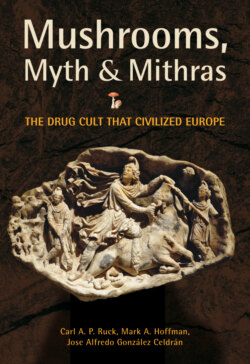Читать книгу Mushrooms, Myth and Mithras - Carl Ruck - Страница 15
На сайте Литреса книга снята с продажи.
Battle Fury
ОглавлениеThe haoma cult appears to have been a basis of the warrior brotherhoods of the Persian Achaemenid dynasty of Cyrus and his successors, and like the later Nordic berserkers,32 the sacrament energized them for battle. In the funeral inscription of Darius at his grave in Naks-i-Rustam near Persepolis, at the end of the uppermost row in a list of twenty-nine countries that brought tribute appears the name Saka Haomavarga, which means “Haoma-wolves,” a confraternity of wolf-warriors bound by the sacrament.33 The berserkers metamorphosed for battle into bears or wolves in the same manner.
The intoxicating nature of the sacrament is well documented. Ctesias, a Greek doctor at the Persian court of Artaxerxes, recorded that he personally assisted at a celebration of Mithras and witnessed the king dance and drink himself into a stupor, a ritual intoxication that was reserved for him alone on this day.34 The followers of Darius were also said to drink urine to induce ecstasy. These combined attributes, physical prowess and intoxicating urine, betray the identity of the sacrament as Amanita muscaria, the fly agaric, for several reasons: first, because ingesting Amanita muscaria is known to induce a heightened stamina and aggressive fury, and also because the metabolite of Amanita muscaria remains psychoactive in the urine of those who have ingested it. In fact, some shamanic societies considered drinking the urine of a person who has eaten Amanita muscaria a superior means of accessing the drug than ingestion of the mushroom itself because the consciousness-altering properties are preserved while the often unpleasant side-effects of eating the mushroom are not. This quality of Amanita muscaria adds further evidence to it being the original identity of Soma-haoma.
In fact, linguistically Soma-haoma may even name the plant as a “spongy thing,” which is to say, a mushroom or fungus.35 The Latin word fungus is cognate with the Greek spongos and German Schwamm and is metaphoric for the spongy texture characteristic of mushrooms.
